
Tiny Tiger Cat Food Ingredients
According to our research, Tiny Tiger manufactures 28 cat food recipes using 105 unique ingredients. To evaluate the quality of ingredients used by Tiny Tiger, we've studied all 105 ingredients. In this article, we'll share our findings on Tiny Tiger ingredients.
| Cat Food Recipes | 28 |
| Unique Ingredients | 105 |
| Artificial Colors | 2 |
| Animal By-Products | 2 |
| Anonymous Meats | 4 |
| Controversial | 11 |
| Harmful | 3 |
First 5 Ingredients
Cat food ingredients in the United States are listed in descending order of pre-cooked weight. The first 5 ingredients typically constitute a significant portion of the recipe.
For Tiny Tiger, these are the most common ingredients found within the first 5 cat food ingredients.
- fish broth
- liver
- liver
- chicken
- meat by-products
As you can see, the most common first ingredient in Tiny Tiger is fish broth. The most common 2nd ingredient is liver, followed by liver, chicken, and meat by-products.
Artificial Food Coloring Dyes
Our records indicate that Tiny Tiger does use artificial food coloring dyes. More specifically, we've identified 2 artificial food dyes used by Tiny Tiger.
Although these food dyes are classified as Generally Recognized As Safe (GRAS) by the FDA, we recommend avoiding them when possible.
According to the Center For Research In The Public Interest (CSPI), there are many potential health risks associated with the consumption of artificial food coloring dyes.
Given that most pets consume the same products for prolonged periods of time, these concerns should be taken seriously. In general, we recommend pet owners avoid feeding products which contain artificial food coloring dyes.
For more information regarding the CSPI's findings, read our artificial food coloring article.
Red 3 is an artificial dye which the FDA has confirmed can cause cancer in laboratory animals.
The following recipes contain red 3:
The ingredient "added color" is ambiguous and may include various artificial dyes. Most artificial dyes have been linked to various chronic diseases.
The following recipes contain added color:
Animal By-Products
Tiny Tiger does indeed use animal by-products. More specifically, 2 animal by-product ingredients were found during our analysis of Tiny Tiger cat food ingredients.
According to AAFCO, by-products are defined as the non-rendered, clean parts, other than meat, derived from slaughtered mammals. In other words, animal by-products are the leftover ingredients that humans typically do not consume (lung, heart, tongue, stomach, intestine, blood, etc).
Many consumers have equated animal by-products with slaughterhouse waste. Animal by-products are still very controversial. Most premium brands have abandoned them in favor of specific named organ ingredients (duck liver, chicken heart, etc).
If you must feed a product with animal by-products, ensure that the specific animal source is specified. In other words, avoid ingredients such as meat by-products or poultry by-products.
By-products are defined by AAFCO as the "non-rendered, clean parts, other than meat, derived from slaughtered mammals." Thus, meat by-products contain nearly all parts of the animal which are typically not consumed by humans. These parts include the liver, lung, spleen, kidney, stomach, blood, intestine, bone, etc.
This ingredient is marked controversial because the meat source is not identified. Anonymous ingredients such as meat by-products are typically very low quality additions. The most unpleasing property of this ingredient is that the animal source can contain any mammal, even dogs & cats.
The following recipes contain meat by-products:
- Tiny Tiger Grain-Free Pate Chicken Recipe
- Tiny Tiger Grain-Free Pate Turkey & Giblets Recipe
- Tiny Tiger Grain-Free Pate Beef Recipe
- Tiny Tiger Grain-Free Pate Whitefish & Tuna Recipe
- Tiny Tiger Grain-Free Pate Salmon Recipe
- Tiny Tiger Grain-Free Pate Seafood Recipe
- Tiny Tiger Grain-Free Chunks In Extra Gravy Chicken Recipe
- Tiny Tiger Grain-Free Chunks In Gravy Chicken Recipe
- Tiny Tiger Grain-Free Chunks In Gravy Turkey Recipe
- Tiny Tiger Grain-Free Chunks In Extra Gravy Tuna Recipe
- Tiny Tiger Grain-Free Chunks In Extra Gravy Salmon & Whitefish Recipe
- Tiny Tiger Grain-Free Chunks In Extra Gravy Turkey Recipe
- Tiny Tiger Grain-Free Chunks In Extra Gravy Beef Recipe
- Tiny Tiger Grain-Free Chunks In Extra Gravy Seafood Recipe
- Tiny Tiger Grain-Free Chunks In Gravy Beef Recipe
- Tiny Tiger Grain-Free Chunks In Gravy Tuna Recipe
- Tiny Tiger Grain-Free Chunks In Gravy Salmon & Whitefish Recipe
- Tiny Tiger Grain-Free Chunks In Gravy Seafood Recipe
Chicken by-product meal is produced by cooking chicken by-products using a process called rendering. By-products are defined by AAFCO as the "non-rendered, clean parts, other than meat, derived from slaughtered mammals." Thus, chicken by-products contain nearly all parts of chickens which are typically not consumed by humans. These parts include the liver, lung, spleen, kidney, stomach, blood, intestine, bone, etc.
Like other meat by-products, chicken by-products are considered controversial, mainly because they are inexpensive ingredients which consumers have equated with slaughterhouse waste. However, manufactures and many experts claim that animal by-products are unjustly criticized. Proponents state that "named" by-products, such as chicken by-products, supply many important nutrients required by cats.
The following recipes contain chicken by-product meal:
Anonymous Meat Ingredients
Anonymous meats are animal-based ingredients which do not provide the source animal's name. These ingredients are controversial because they can come from almost any animal.
In addition, anonymous animal-based ingredients are very inexpensive and often the lowest quality meats that are still allowed to be used in pet food.
In general, we do not recommend feeding any products which contain anonymous meats. When in doubt, always contact the brand's customer service desk for further clarification.
Unfortunately, we've identified 4 anonymous meat ingredients used by Tiny Tiger.
Fish is typically an excellent protein and fat source. However, the specific type of fish is not mentioned and therefore we cannot discuss any specific qualities of this ingredient. In general, anonymous ingredients are low quality inclusions when compared to ingredients such as mackerel, cod, salmon, etc.
The following recipes contain fish:
Poultry is a controversial ingredient because the source animal is not specified. Anonymous ingredients such as poultry are typically low-quality ingredients in comparison to named protein sources (e.g. chicken, turkey, duck).
The following recipes contain poultry:
By-products are defined by AAFCO as the "non-rendered, clean parts, other than meat, derived from slaughtered mammals." Thus, meat by-products contain nearly all parts of the animal which are typically not consumed by humans. These parts include the liver, lung, spleen, kidney, stomach, blood, intestine, bone, etc.
This ingredient is marked controversial because the meat source is not identified. Anonymous ingredients such as meat by-products are typically very low quality additions. The most unpleasing property of this ingredient is that the animal source can contain any mammal, even dogs & cats.
The following recipes contain meat by-products:
- Tiny Tiger Grain-Free Pate Chicken Recipe
- Tiny Tiger Grain-Free Pate Turkey & Giblets Recipe
- Tiny Tiger Grain-Free Pate Beef Recipe
- Tiny Tiger Grain-Free Pate Whitefish & Tuna Recipe
- Tiny Tiger Grain-Free Pate Salmon Recipe
- Tiny Tiger Grain-Free Pate Seafood Recipe
- Tiny Tiger Grain-Free Chunks In Extra Gravy Chicken Recipe
- Tiny Tiger Grain-Free Chunks In Gravy Chicken Recipe
- Tiny Tiger Grain-Free Chunks In Gravy Turkey Recipe
- Tiny Tiger Grain-Free Chunks In Extra Gravy Tuna Recipe
- Tiny Tiger Grain-Free Chunks In Extra Gravy Salmon & Whitefish Recipe
- Tiny Tiger Grain-Free Chunks In Extra Gravy Turkey Recipe
- Tiny Tiger Grain-Free Chunks In Extra Gravy Beef Recipe
- Tiny Tiger Grain-Free Chunks In Extra Gravy Seafood Recipe
- Tiny Tiger Grain-Free Chunks In Gravy Beef Recipe
- Tiny Tiger Grain-Free Chunks In Gravy Tuna Recipe
- Tiny Tiger Grain-Free Chunks In Gravy Salmon & Whitefish Recipe
- Tiny Tiger Grain-Free Chunks In Gravy Seafood Recipe
Poultry giblets includes the heart, liver, gizzards, and other internal organs of poultry. Organs are nutritiously dense ingredients which provide high quality protein and fat. However, this particular ingredient is considered an anonymous meat ingredient because the type of poultry is not specified. In order words, "named" giblets such as chicken giblets or turkey giblets are preferred over poultry giblets.
The following recipes contain poultry giblets:
Cereal Grains
Certain Tiny Tiger cat food recipes contain one or more grains. The specific ingredients are listed below.
For cats, we typically recommend choosing a grain-free recipe. Cats are obligate carnivores and therefore grains are not species appropriate.
The kibble production requires a binding agent. Grains are commonly used for this purpose in cat food. When purchasing grain-free cat food, grains are often replaced with another starchy source. This is also not ideal.
To avoid grains and other starchy additions, consider feeding wet or frozen recipes.
Ground grain sorghum is a gluten-free carbohydrate source. This cereal grain also provides a modest amount of B vitamins and minerals such as magnesium, iron, phosphorus, and manganese.
The following recipes contain ground grain sorghum:
Corn gluten meal is a by-product from the production of various corn products (corn starch, corn syrup, etc). It's very high in protein (nearly 60% protein) and therefore can significant boost the protein content of the product. Because plant based proteins such as corn gluten meal are inferior to meat based proteins (lack many essential amino acids), they are not suitable substitutes.
The following recipes contain corn gluten meal:
Ground corn is a cereal grain which provides a modest amount of vitamins, minerals, and plant based protein. It also happens to be one of the most controversial ingredients in cat food.
Proponents of corn claim that corn is highly digestible and an excellent source of protein, energy, vitamins, minerals, and essential fatty acids.
Opponents however believe that positive claims in regards to corn are either half-truths or completely false, we'll discuss a few of the opposing arguments.
In regards to digestibility, the claims of "highly digestible" are only true if corn is processed into a meal or flour and subsequently cooked. In regards to the protein contribution, we must note that corn is a plant based protein which does not contain all of the necessary amino acids required by cats to sustain life. Therefore substituting corn for meat is an unsuitable substitution and actually degrades the overall protein quality of the product.
Finally, we'll discuss the claims about vitamins and minerals in corn. Although corn does provide many vitamins and minerals, it not necessarily an exceptional ingredient in this regards. There are many other ingredients which are more complete and biologically appropriate. Therefore the usage of corn as the primary ingredient in cat food should certainly warrant further questioning.
The following recipes contain ground corn:
Brewer's rice is the small fragments of rice kernel that are separated from the larger kernels of milled rice. The fragments do not contain the same nutrition profile of the whole kernel and therefore brewer's rice is a lower quality grain. Brewer's rice is typically regarded as an inexpensive and low quality filler.
The following recipes contain brewers rice:
Ground wheat is regarded as an inexpensive and low-quality filler in pet food. However, wheat does provide plant-based protein and makes pet food more affordable for consumers. It's important to note that plant based protein does not provide the same amino acid profile as meat based protein.
The following recipes contain ground wheat:
Controversial Ingredients
In most cases, ingredients which are given the controversial classification can be substituted with higher-quality alternatives. You should evaluate each controversial ingredient independently to see if there is truly a valid cause for concern.
Keep in mind, certain sacrifices often must be made to produce cat foods at a reasonable price. In general, the more expensive the product, the fewer controversial ingredients you'll find.
In our analysis, we've identified 11 controversial ingredients inside Tiny Tiger products. These controversial ingredients are listed below. Click on each ingredient for more information.
Corn gluten meal is a by-product from the production of various corn products (corn starch, corn syrup, etc). It's very high in protein (nearly 60% protein) and therefore can significant boost the protein content of the product. Because plant based proteins such as corn gluten meal are inferior to meat based proteins (lack many essential amino acids), they are not suitable substitutes.
The following recipes contain corn gluten meal:
Ground corn is a cereal grain which provides a modest amount of vitamins, minerals, and plant based protein. It also happens to be one of the most controversial ingredients in cat food.
Proponents of corn claim that corn is highly digestible and an excellent source of protein, energy, vitamins, minerals, and essential fatty acids.
Opponents however believe that positive claims in regards to corn are either half-truths or completely false, we'll discuss a few of the opposing arguments.
In regards to digestibility, the claims of "highly digestible" are only true if corn is processed into a meal or flour and subsequently cooked. In regards to the protein contribution, we must note that corn is a plant based protein which does not contain all of the necessary amino acids required by cats to sustain life. Therefore substituting corn for meat is an unsuitable substitution and actually degrades the overall protein quality of the product.
Finally, we'll discuss the claims about vitamins and minerals in corn. Although corn does provide many vitamins and minerals, it not necessarily an exceptional ingredient in this regards. There are many other ingredients which are more complete and biologically appropriate. Therefore the usage of corn as the primary ingredient in cat food should certainly warrant further questioning.
The following recipes contain ground corn:
Brewer's rice is the small fragments of rice kernel that are separated from the larger kernels of milled rice. The fragments do not contain the same nutrition profile of the whole kernel and therefore brewer's rice is a lower quality grain. Brewer's rice is typically regarded as an inexpensive and low quality filler.
The following recipes contain brewers rice:
Ground wheat is regarded as an inexpensive and low-quality filler in pet food. However, wheat does provide plant-based protein and makes pet food more affordable for consumers. It's important to note that plant based protein does not provide the same amino acid profile as meat based protein.
The following recipes contain ground wheat:
Caramel color is a concentrated form of caramel, a natural food colorant. Caramel color has been linked to cancer in laboratory animals. Since our pets do not care about food color, caramel color is an unnecessary addition with possible health risks.
The following recipes contain caramel color:
Poultry is a controversial ingredient because the source animal is not specified. Anonymous ingredients such as poultry are typically low-quality ingredients in comparison to named protein sources (e.g. chicken, turkey, duck).
The following recipes contain poultry:
Liver is a controversial ingredient because the source animal is not specified. Anonymous animal ingredients are typically very low quality and may contain almost any animal, including dogs and cats!
The following recipes contain liver:
- Tiny Tiger Grain-Free Pate Chicken Recipe
- Tiny Tiger Grain-Free Pate Turkey & Giblets Recipe
- Tiny Tiger Grain-Free Pate Beef Recipe
- Tiny Tiger Grain-Free Pate Whitefish & Tuna Recipe
- Tiny Tiger Grain-Free Pate Salmon Recipe
- Tiny Tiger Grain-Free Pate Seafood Recipe
- Tiny Tiger Grain-Free Chunks In Extra Gravy Chicken Recipe
- Tiny Tiger Grain-Free Chunks In Gravy Chicken Recipe
- Tiny Tiger Grain-Free Chunks In Gravy Turkey Recipe
- Tiny Tiger Grain-Free Chunks In Extra Gravy Tuna Recipe
- Tiny Tiger Grain-Free Chunks In Extra Gravy Salmon & Whitefish Recipe
- Tiny Tiger Grain-Free Chunks In Extra Gravy Turkey Recipe
- Tiny Tiger Grain-Free Chunks In Extra Gravy Beef Recipe
- Tiny Tiger Grain-Free Chunks In Extra Gravy Seafood Recipe
- Tiny Tiger Grain-Free Chunks In Gravy Beef Recipe
- Tiny Tiger Grain-Free Chunks In Gravy Tuna Recipe
- Tiny Tiger Grain-Free Chunks In Gravy Salmon & Whitefish Recipe
- Tiny Tiger Grain-Free Chunks In Gravy Seafood Recipe
By-products are defined by AAFCO as the "non-rendered, clean parts, other than meat, derived from slaughtered mammals." Thus, meat by-products contain nearly all parts of the animal which are typically not consumed by humans. These parts include the liver, lung, spleen, kidney, stomach, blood, intestine, bone, etc.
This ingredient is marked controversial because the meat source is not identified. Anonymous ingredients such as meat by-products are typically very low quality additions. The most unpleasing property of this ingredient is that the animal source can contain any mammal, even dogs & cats.
The following recipes contain meat by-products:
- Tiny Tiger Grain-Free Pate Chicken Recipe
- Tiny Tiger Grain-Free Pate Turkey & Giblets Recipe
- Tiny Tiger Grain-Free Pate Beef Recipe
- Tiny Tiger Grain-Free Pate Whitefish & Tuna Recipe
- Tiny Tiger Grain-Free Pate Salmon Recipe
- Tiny Tiger Grain-Free Pate Seafood Recipe
- Tiny Tiger Grain-Free Chunks In Extra Gravy Chicken Recipe
- Tiny Tiger Grain-Free Chunks In Gravy Chicken Recipe
- Tiny Tiger Grain-Free Chunks In Gravy Turkey Recipe
- Tiny Tiger Grain-Free Chunks In Extra Gravy Tuna Recipe
- Tiny Tiger Grain-Free Chunks In Extra Gravy Salmon & Whitefish Recipe
- Tiny Tiger Grain-Free Chunks In Extra Gravy Turkey Recipe
- Tiny Tiger Grain-Free Chunks In Extra Gravy Beef Recipe
- Tiny Tiger Grain-Free Chunks In Extra Gravy Seafood Recipe
- Tiny Tiger Grain-Free Chunks In Gravy Beef Recipe
- Tiny Tiger Grain-Free Chunks In Gravy Tuna Recipe
- Tiny Tiger Grain-Free Chunks In Gravy Salmon & Whitefish Recipe
- Tiny Tiger Grain-Free Chunks In Gravy Seafood Recipe
Poultry giblets includes the heart, liver, gizzards, and other internal organs of poultry. Organs are nutritiously dense ingredients which provide high quality protein and fat. However, this particular ingredient is considered an anonymous meat ingredient because the type of poultry is not specified. In order words, "named" giblets such as chicken giblets or turkey giblets are preferred over poultry giblets.
The following recipes contain poultry giblets:
Chicken by-product meal is produced by cooking chicken by-products using a process called rendering. By-products are defined by AAFCO as the "non-rendered, clean parts, other than meat, derived from slaughtered mammals." Thus, chicken by-products contain nearly all parts of chickens which are typically not consumed by humans. These parts include the liver, lung, spleen, kidney, stomach, blood, intestine, bone, etc.
Like other meat by-products, chicken by-products are considered controversial, mainly because they are inexpensive ingredients which consumers have equated with slaughterhouse waste. However, manufactures and many experts claim that animal by-products are unjustly criticized. Proponents state that "named" by-products, such as chicken by-products, supply many important nutrients required by cats.
The following recipes contain chicken by-product meal:
Corn flour a ground cereal grain which provides a modest amount of vitamins, minerals, and plant based protein. It also happens to be one of the most controversial ingredients in cat food.
Proponents of corn claim that corn is highly digestible and an excellent source of protein, energy, vitamins, minerals, and essential fatty acids.
Opponents however believe that positive claims in regards to corn are either half-truths or completely false, we'll discuss a few of the opposing arguments.
In regards to digestibility, the claims of "highly digestible" are only true if corn is processed into a meal or flour and subsequently cooked. In regards to the protein contribution, we must note that corn is a plant based protein which does not contain all of the necessary amino acids required by cats to sustain life. Therefore substituting corn for meat is an unsuitable substitution and actually degrades the overall protein quality of the product.
Finally, we'll discuss the claims about vitamins and minerals in corn. Although corn does provide many vitamins and minerals, it not necessarily an exceptional ingredient in this regards. There are many other ingredients which are more complete and biologically appropriate. Therefore the usage of corn as the primary ingredient in cat food should certainly warrant further questioning.
The following recipes contain corn flour:
Potentially Harmful Ingredients
Harmful ingredients are those which have been linked to adverse health effects. In general, we do not recommend feeding any product which contains any harmful ingredients.
There are certain situations where these ingredients may be necessary. We always recommend contacting Tiny Tiger for further clarification regarding any harmful or controversial ingredient.
We have identified 3 harmful ingredients used in certain Tiny Tiger recipes. To learn more, click on the ingredient's name.
Red 3 is an artificial dye which the FDA has confirmed can cause cancer in laboratory animals.
The following recipes contain red 3:
The ingredient "added color" is ambiguous and may include various artificial dyes. Most artificial dyes have been linked to various chronic diseases.
The following recipes contain added color:
Menadione sodium bisulfite complex is a synthetic version of vitamin K that has been linked to many health concerns. Research has suggested possible toxic reactions in liver cells and red blood cells among other serious problems. In fact, one large chemical supplier warns, "The substance is toxic to kidneys, lungs, liver, mucous membranes. Repeated or prolonged exposure to the substance can produce target organs damage."
The following recipes contain menadione sodium bisulfite complex:
Tiny Tiger Cat Food Ingredient Lists
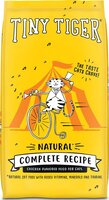
Tiny Tiger
Natural Complete Recipe
Chicken Flavored Food For Cats
Tiny Tiger
Natural Complete Recipe Chicken Flavored Food For Cats
First Five Ingredients
chicken by-product mealcorn gluten meal
soybean meal
brewers rice
ground wheat
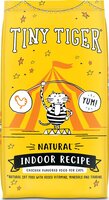
Tiny Tiger
Natural Indoor Recipe
Chicken Flavored Food For Cats
Tiny Tiger
Natural Indoor Recipe Chicken Flavored Food For Cats
First Five Ingredients
chicken by-product mealground corn
ground grain sorghum
corn gluten meal
soybean meal
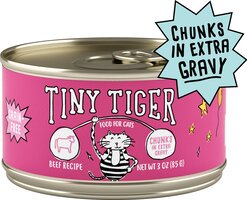
Tiny Tiger
Grain-Free Chunks In Extra Gravy
Beef Recipe
Tiny Tiger
Grain-Free Chunks In Extra Gravy Beef Recipe
First Five Ingredients
beef brothbeef
liver
poultry
meat by-products
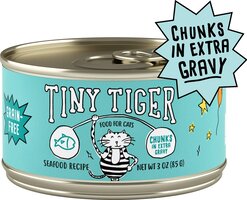
Tiny Tiger
Grain-Free Chunks In Extra Gravy
Seafood Recipe
Tiny Tiger
Grain-Free Chunks In Extra Gravy Seafood Recipe
First Five Ingredients
fish brothocean fish
liver
chicken
shrimp
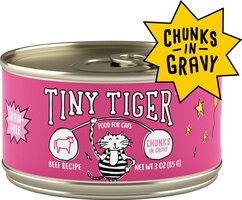
Tiny Tiger
Grain-Free Chunks In Gravy
Beef Recipe
Tiny Tiger
Grain-Free Chunks In Gravy Beef Recipe
First Five Ingredients
beef brothbeef
liver
poultry
meat by-products
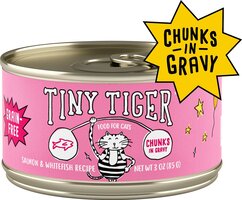
Tiny Tiger
Grain-Free Chunks In Gravy
Salmon & Whitefish Recipe
Tiny Tiger
Grain-Free Chunks In Gravy Salmon & Whitefish Recipe
First Five Ingredients
fish brothsalmon
liver
chicken
whitefish
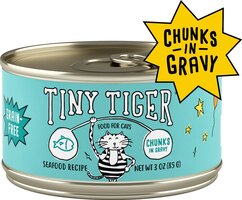
Tiny Tiger
Grain-Free Chunks In Gravy
Seafood Recipe
Tiny Tiger
Grain-Free Chunks In Gravy Seafood Recipe
First Five Ingredients
fish brothocean fish
liver
chicken
meat by-products
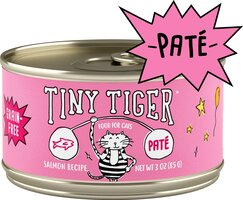
Tiny Tiger
Grain-Free Pate
Salmon Recipe
Tiny Tiger
Grain-Free Pate Salmon Recipe
First Five Ingredients
salmonliver
meat by-products
fish broth
fish
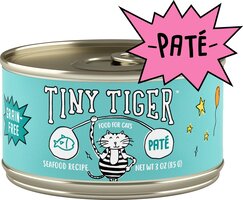
Tiny Tiger
Grain-Free Pate
Seafood Recipe
Tiny Tiger
Grain-Free Pate Seafood Recipe
First Five Ingredients
ocean fishliver
meat by-products
fish broth
natural flavor
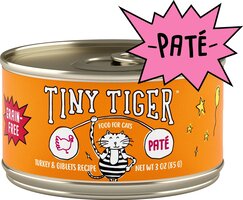
Tiny Tiger
Grain-Free Pate
Turkey & Giblets Recipe
Tiny Tiger
Grain-Free Pate Turkey & Giblets Recipe
First Five Ingredients
turkeyliver
meat by-products
turkey broth
poultry giblets
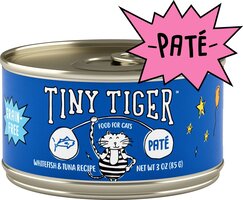
Tiny Tiger
Grain-Free Pate
Whitefish & Tuna Recipe
Tiny Tiger
Grain-Free Pate Whitefish & Tuna Recipe
First Five Ingredients
ocean whitefishliver
fish
meat by-products
fish broth
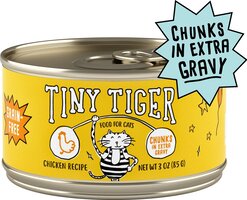
Tiny Tiger
Grain-Free Chunks In Extra Gravy
Chicken Recipe
Tiny Tiger
Grain-Free Chunks In Extra Gravy Chicken Recipe
First Five Ingredients
chicken brothchicken
liver
turkey
meat by-products
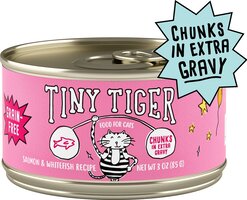
Tiny Tiger
Grain-Free Chunks In Extra Gravy
Salmon & Whitefish Recipe
Tiny Tiger
Grain-Free Chunks In Extra Gravy Salmon & Whitefish Recipe
First Five Ingredients
fish brothsalmon
liver
chicken
whitefish
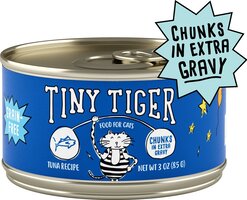
Tiny Tiger
Grain-Free Chunks In Extra Gravy
Tuna Recipe
Tiny Tiger
Grain-Free Chunks In Extra Gravy Tuna Recipe
First Five Ingredients
fish brothtuna
chicken
liver
meat by-products
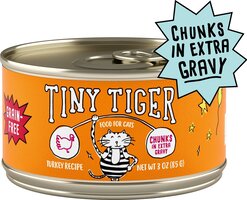
Tiny Tiger
Grain-Free Chunks In Extra Gravy
Turkey Recipe
Tiny Tiger
Grain-Free Chunks In Extra Gravy Turkey Recipe
First Five Ingredients
turkey brothturkey
liver
chicken
meat by-products
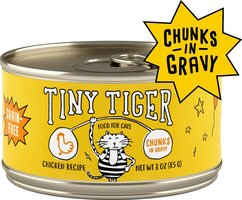
Tiny Tiger
Grain-Free Chunks In Gravy
Chicken Recipe
Tiny Tiger
Grain-Free Chunks In Gravy Chicken Recipe
First Five Ingredients
chicken brothchicken
liver
turkey
meat by-products
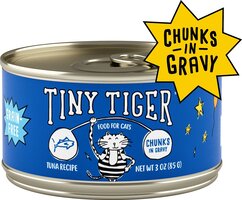
Tiny Tiger
Grain-Free Chunks In Gravy
Tuna Recipe
Tiny Tiger
Grain-Free Chunks In Gravy Tuna Recipe
First Five Ingredients
fish brothtuna
chicken
liver
meat by-products
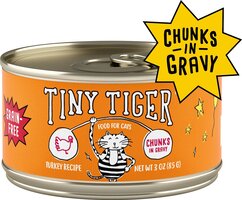
Tiny Tiger
Grain-Free Chunks In Gravy
Turkey Recipe
Tiny Tiger
Grain-Free Chunks In Gravy Turkey Recipe
First Five Ingredients
turkey brothturkey
liver
chicken
meat by-products
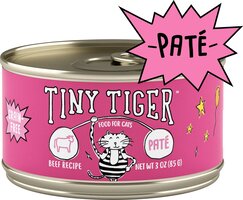
Tiny Tiger
Grain-Free Pate
Beef Recipe
Tiny Tiger
Grain-Free Pate Beef Recipe
First Five Ingredients
beefmeat broth
liver
fish
meat by-products
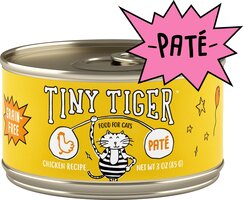
Tiny Tiger
Grain-Free Pate
Chicken Recipe
Tiny Tiger
Grain-Free Pate Chicken Recipe
First Five Ingredients
chickenchicken broth
liver
meat by-products
fish
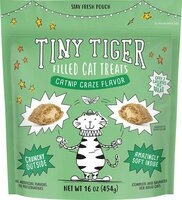
Tiny Tiger
Filled Cat Treats
Catnip Craze Flavor
Tiny Tiger
Filled Cat Treats Catnip Craze Flavor
First Five Ingredients
chicken by-product mealbarley flour
pea starch
chicken fat
lactic acid
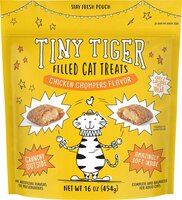
Tiny Tiger
Filled Cat Treats
Chicken Chompers Flavor
Tiny Tiger
Filled Cat Treats Chicken Chompers Flavor
First Five Ingredients
chicken by-product mealbarley flour
chicken fat
pea starch
lactic acid

Tiny Tiger
Filled Cat Treats
Tuna Tidbits Flavor
Tiny Tiger
Filled Cat Treats Tuna Tidbits Flavor
First Five Ingredients
chicken by-product mealbarley flour
chicken fat
pea starch
lactic acid
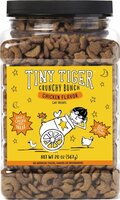
Tiny Tiger
Crunchy Bunch
Chicken Flavor Cat Treats
Tiny Tiger
Crunchy Bunch Chicken Flavor Cat Treats
First Five Ingredients
chicken mealcorn flour
soybean meal
chicken fat
corn gluten meal
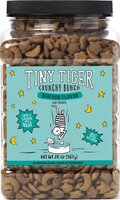
Tiny Tiger
Crunchy Bunch
Seafood Flavor Cat Treats
Tiny Tiger
Crunchy Bunch Seafood Flavor Cat Treats
First Five Ingredients
chicken mealcorn flour
soybean meal
chicken fat
corn gluten meal
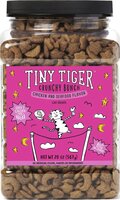
Tiny Tiger
Crunchy Bunch
Chicken and Seafood Flavor Cat Treats
Tiny Tiger
Crunchy Bunch Chicken and Seafood Flavor Cat Treats
First Five Ingredients
chicken mealcorn flour
soybean meal
chicken fat
corn gluten meal
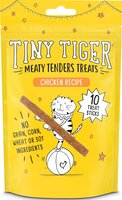
Tiny Tiger
Meaty Tender Sticks
Chicken Recipe
Tiny Tiger
Meaty Tender Sticks Chicken Recipe
First Five Ingredients
chickenchickpea
coconut glycerin
pork
pork gelatin
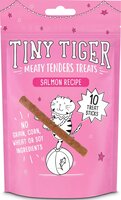
Tiny Tiger
Meaty Tender Sticks
Salmon Recipe
Tiny Tiger
Meaty Tender Sticks Salmon Recipe
First Five Ingredients
salmonchicken
chickpea
coconut glycerin
pork
